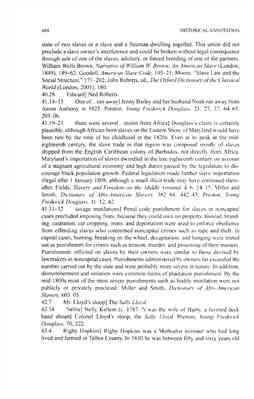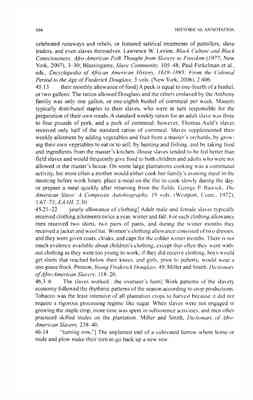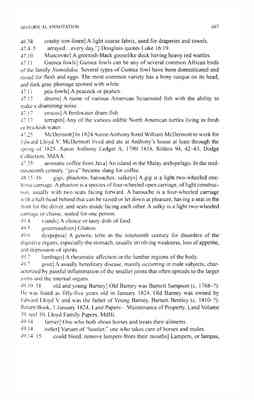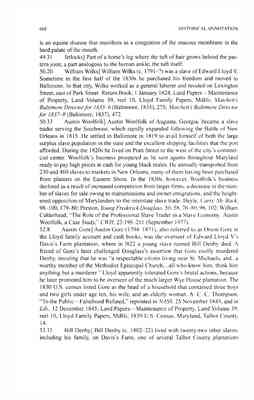Pages
36
664 HISTORICAL ANNOTATION
state of two slaves or a slave and a freeman dwelling together. This union did not preclude a slave owner's interference and could be broken without legal consequence through sale of one of the slaves, adultery, or forced breeding of one of the partners. William Wells Brown, Narrative of William W. Brown: An American Slave (London, 1849), 149-62; Goodell, American Slave Code, 105-21; Moore, "Slave Law and the Social Structure," 171-202; John Roberts, ed., The Oxford Dictionary of the Classical World (London, 2005), 180. 40.28 Edward] Ned Roberts. 41.14-15 One of. . .ran away] Jenny Bailey and her husband Noah ran away from Aaron Anthony in 1825. Preston, Young Frederick Douglass, 21, 27, 37, 64-65, 205-06. 41.19-21 there were several. . .stolen from Africa] Douglass's claim is certainly plausible, although African-born slaves on the Eastern Shore of Maryland would have been rare by the time of his childhood in the 1820s. Even at its peak in the mideighteenth century, the slave trade in that region was composed mostly of slaves shipped from the English Caribbean colony of Barbados, not directly from Africa. Maryland's importation of slaves dwindled in the late eighteenth century on account of a stagnant agricultural economy and high duties passed by the legislature to discourage black population growth. Federal legislation made further slave importation illegal after 1 January 1808, although a small illicit trade may have continued thereafter. Fields, Slavery and Freedom on the Middle Ground, 4-6, 14-15; Miller and Smith, Dictionary of Afro-American Slavery, 382-84, 442-43; Preston, Young Frederick Douglass, 11-12, 42. 41.31-32 savage mutilations] Penal code punishment for slaves in noncapital cases precluded imposing fines, because they could own no property. Instead, branding, castration, ear cropping, irons, and deportation were used to enforce obedience from offending slaves who committed noncapital crimes such as rape and theft. In capital cases, burning, breaking on the wheel, decapitation, and hanging were meted out as punishment for crimes such as treason, murder, and poisoning of their masters. Punishments inflicted on slaves by their owners were similar to those devised by lawmakers in noncapital cases. Punishments administered by owners far exceeded the number carried out by the state and were probably more severe in nature. In addition, dismemberment and isolation were common forms of plantation punishment. By the mid-1800s most of the most severe punishments such as bodily mutilation were not publicly or privately practiced. Miller and Smith, Dictionary of Afro-American Slavery, 603-05. 42.7 Mr. Lloyd 's sloop] The Sally Lloyd. 42.14 Nellie] Nelly Kellem (c. 1787-?) was the wife of Harry, a favored deck hand aboard Colonel Lloyd 's sloop, the Sally Lloyd. Preston, Young Frederick Douglass, 70, 222. 43.4 Rigby Hopkins] Rigby Hopkins was a Methodist minister who had long lived and farmed in Talbot County. In 1830 he was between fifty and sixty years old
37
HISTORICAL ANNOTATION 665
and had within his household two white males, six white females, and one black female. Whereas in 1820 he owned seventeen slaves, in 1830 he had none, possibly indicating a preference for renting black labor by then. 1820 U.S. Census, Maryland, Talbot County, 19; 1830 U.S. Census, Maryland, Talbot County, 31; Preston, Young Frederick Douglass, 130. 43.35 uncles Harry, Peter, and Jake] One of the slave crew of the Sally Lloyd, Harry was Harry Kellem, husband of Nelly. The business records of Edward Lloyd V give the birth year for a slave named Peter as 1799. Land Papers--Maintenance of Property, Land Volume 39, reel 10, Lloyd Family Papers, MdHi. 44.17 Ireland, in the days of want and famine] In the 1840s over 75 percent of the Irish population was dependent upon agriculture, most cultivating potatoes on small plots. A partial potato crop failure occurred in the fall of 1845. The potato blight spread in 1846, resulting in a complete crop failure and a famine throughout the country. In 1847 the blight was less severe, but living conditions, especially among the poor, were still terrible. Famine and starvation left people susceptible to disease, fever, dysentery, scurvy, cholera, influenza, and typhus. During the famine and afterward, England continued to export grain and animal products from Ireland. Government relief efforts were, on the whole, too little and too late. They consisted of the importation of Indian corn from the United States as a basic food source, employment of the poor through public works, the building of workhouses, and the establishment of soup kitchens and fever hospitals. Some private charity was helpful at a local level, with the Quakers as leading contributors. The most noticeable effect of the famine was the loss of population. From 1841 to 1851 there was a loss of two million people, mainly on account of mass emigration. Starvation caused the deaths of 20,000 from 1846 to 1851, and 339,000 died from disease. From 31 August 1845 to 6 January 1846, Frederick Douglass visited Dublin, Cork, Limerick, and Belfast while on an abolitionist speaking tour of Ireland. Douglass Papers, ser. 1, 1:xcvi-xcvii; Edward Norman, A History of Modern Ireland ( London, 1971), 108-17; Noel Kissane, The Irish Famine A Documentary History (Dublin, Ire., 1995), 27, 46-48, 75, 107-08, 123. 44.21-24 "I am going away. . .O, yea! O, yea!"] Douglass recalled this song in both of his earlier autobiographies. Douglass Papers, ser. 2, 1:20, 2:57. 44.33-38 "I did not. . .ineffable sadness."] Douglass offers a close paraphrase of his statement in the Narrative. He repeated the passage in My Bondage and My Freedom, Douglass Papers, ser. 2, 1:20, 2:58. 45.5-6 The songs. . .their joys] Slaves' songs were an important and regular part of work and home life. Both secular and sacred music enabled bondsmen to communicate with one another in improvised codes that their owners did not understand. Because they employed techniques like innuendo, these songs could be sung in front of whites as a form of resistance. When in a master's presence, slaves sang songs that seemed to reflect a more positive view of their situation than was the case. However, the majority of antebellum slave songs focused on the oppressive conditions of daily life and work, such as cruel treatment at the hands of a master or overseer. Some songs
38
666 HISTORICAL ANNOTATION
celebrated runaways and rebels, or featured satirical treatments of patrollers, slave traders, and even slaves themselves. Lawrence W. Levine, Black Culture and Black Consciousness: Afro-American Folk Thought from Slavery to Freedom ( 1977; New York, 2007), 3-30; Blassingame, Slave Community, 105-48; Paul Finkelman et al., eds., Encyclopedia of African American History, 1619-1895: From the Colonial Period to the Age of Frederick Douglass, 3 vols. (New York, 2006), 2:406. 45.13 their monthly allowance of food] A peck is equal to one-fourth of a bushel, or two gallons. The ration allowed Douglass and the others enslaved by the Anthony family was only one gallon, or one-eighth bushel of cornmeal per week. Masters typically distributed staples to their slaves, who were in turn responsible for the preparation of their own meals. A standard weekly ration for an adult slave was three to four pounds of pork, and a peck of cornmeal; however, Thomas Auld's slaves received only half of the standard ration of cornmeal. Slaves supplemented their weekly allotment by adding vegetables and fruit from a master's orchards, by growing their own vegetables to eat or to sell, by hunting and fishing, and by taking food and ingredients from the master's kitchen. House slaves tended to be fed better than field slaves and would frequently give food to both children and adults who were not allowed in the master's house. On some large plantations cooking was a communal activity, but most often a mother would either cook her family's evening meal in the morning before work hours, place a meal on the fire to cook slowly during the day, or prepare a meal quickly after returning from the fields. George P. Rawick, The American Slave: A Composite Autobiography, 19 vols. (Westport, Conn., 1972), 1:67-73; EAAH, 2:30. 45.21-22 yearly allowance of clothing] Adult male and female slaves typically received clothing allotments twice a year, winter and fall. For each clothing allowance men received two shirts, two pairs of pants, and during the winter months they received a jacket and wool hat. Women's clothing allowance consisted of two dresses, and they were given coats, cloaks, and caps for the colder winter months. There is not much evidence available about children's clothing, except that often they went without clothing as they were too young to work; if they did receive clothing, boys would get shirts that reached below their knees, and girls, prior to puberty, would wear a one-piece frock. Preston, Young Frederick Douglass, 49; Miller and Smith, Dictionary of Afro-American Slavery, 118-20. 46.3-6 The slaves worked. . .the overseer's horn] Work patterns of the slavery economy followed the rhythmic patterns of the season according to crop productions. Tobacco was the least intensive of all plantation crops to harvest because it did not require a rigorous processing regime like sugar. When slaves were not engaged in growing the staple crop, more time was spent in subsistence activities, and men often practiced skilled trades on the plantation. Miller and Smith, Dictionary of AfroAmerican Slavery, 238-40. 46.14 "turning row,"] The unplanted end of a cultivated furrow where horse or mule and plow make their turn to go back up a new row.
39
HISTORICAL ANNOTATION 667
46.34 crashy tow-linen] A light coarse fabric, used for draperies and towels. 47.4--5 arrayed. . .every day."] Douglass quotes Luke 16:19. 47.10 Muscovite] A greenish-black gooselike duck having heavy red wattles. 47.11 Guinea fowls] Guinea fowls can be any of several common African birds of the family Numididea. Several types of Guinea fowl have been domesticated and raised for flesh and eggs. The most common variety has a bony casque on its head, and dark gray plumage spotted with white . 47.11 pea-fowls] A peacock or peahen. 47.17 drums] A name of various American Sciaenoird fish with the ability to make a drumming noise. 47.17 crocus] A freshwater drum-fish. 47.17 terrapin] Any of the various edible North American turtles living in fresh or brackish water. 47.25 McDermott] In 1824 Aaron Anthony hired William McDermott to work for Edward Lloyd V. McDermott lived and ate at Anthony's house at least through the spring of 1825. Aaron Anthony Ledger A, 1790-1818, folders 94, 42-43, Dodge Collection, MdAA. 47.33 aromatic coffee from Java] An island in the Malay archipelago. In the midnineteenth century, "java" became slang for coffee. 48.15-16 gigs, phaetons, barouches, sulkeys] A gig is a light two-wheeled onehorse carriage. A phaeton is a species of four-wheeled open carriage, of light construction, usually with two seats facing forward. A barouche is a four-wheeled carriage with a half-head behind that can be raised or let down at pleasure, having a seat in the front for the driver, and seats inside facing each other. A sulky is a light two-wheeled carriage or chaise, seated for one person. 49.4 viands] A choice or tasty dish of food. 49.5 gourmandizer] Glutton. 49.6 dyspepsia] A generic term in the nineteenth century for disorders of the digestive organs, especially the stomach, usually involving weakness, loss of appetite, and depression of spirits. 49.7 lumbago] A rheumatic affection in the lumbar regions of the body. 49.7 gout] A usually hereditary disease, mainly occurring in male subjects; characterized by painful inflammation of the smaller joints that often spreads to the larger joints and the internal organs. 49.10-11 old and young Barney] Old Barney was Barnett Sampson (c. 1768-?). He was listed as fifty-five years old in January 1824. Old Barney was owned by Edward Lloyd V and was the father of Young Barney, Barnett Bentley (c. 1810-?). Return Book, 1 January 1824, Land Papers--Maintenance of Property, Land Volume 39, reel 10, Lloyd Family Papers, MdHi. 49.14 farrier] One who both shoes horses and treats their ailments. 49.14 ostler] Variant of "hostler,'' one who takes care of horses and mules. 49.14-15 could bleed, remove lampers from their mouths] Lampers, or lampas,
40
668 HISTORICAL ANNOTATION
is an equine disease that manifests as a congestion of the mucous membrane in the hard palate of the mouth. 49.31 fetlocks] Part of a horse's leg where the tuft of hair grows behind the pastern joint, a part analogous to the human ankle; the tuft itself. 50.20 William Wilks] William Wilks (c. 1791-?) was a slave of Edward Lloyd V. Sometime in the first half of the 1830s he purchased his freedom and moved to Baltimore. In that city, Wilks worked as a general laborer and resided on Lexington Street, east of Park Street. Return Book, 1 January 1824, Land Papers--Maintenance of Property, Land Volume 39, reel 10, Lloyd Family Papers, MdHi; Matchett's Baltimore Director for 1835-6 (Baltimore, 1835), 275; Matchett's Baltimore Director for 1837-8 (Baltimore, 1837), 472. 50.33 Austin Woolfolk] Austin Woolfolk of Augusta, Georgia, became a slave trader serving the Southwest, which rapidly expanded following the Battle of New Orleans in 1815. He settled in Baltimore in 1819 to avail himself of both the large surplus slave population in the state and the excellent shipping facilities that the port afforded. During the 1820s he lived on Pratt Street to the west of the city's commercial center. Woolfolk's business prospered as he sent agents throughout Maryland ready to pay high prices in cash for young black males. He annually transported from 230 and 460 slaves to markets in New Orleans, many of them having been purchased from planters on the Eastern Shore. In the 1830s, however, Woolfolk's business declined as a result of increased competition from larger firms, a decrease in the number of slaves for sale owing to manumissions and owner emigrations, and the heightened opposition of Marylanders to the interstate slave trade. Deyle, Carry Me Back, 98-100, 179-80; Preston, Young Frederick Douglass, 50, 58, 76-80, 96, 102; William Calderhead, "The Role of the Professional Slave Trader in a Slave Economy: Austin Woolfolk, a Case Study," CWH, 23:195-211 (September 1977). 52.8 Austin Gore] Austin Gore (1794-1871), also referred to as Orson Gore in the Lloyd family account and cash books, was the overseer of Edward Lloyd V's Davis's Farm plantation, where in 1822 a young slave named Bill Denby died. A friend of Gore's later challenged Douglass's assertion that Gore coolly murdered Denby, insisting that he was "a respectable citizen living near St. Michaels, and. . .a worthy member of the Methodist Episcopal Church;. . .all who know him, think him anything but a murderer." Lloyd apparently tolerated Gore's brutal actions, because he later promoted him to be overseer of the much larger Wye House plantation. The 1830 U.S. census listed Gore as the head of a household that contained three boys and two girls under age ten, his wife, and an elderly woman. A. C. C. Thompson, 'To the Public--Falsehood Refuted," reprinted in NASS, 25 November 1845, and in Lib., 12 December 1845; Land Papers--Maintenance of Property, Land Volume 39, reel 10, Lloyd Family Papers, MdHi; 1830 U.S. Census, Maryland, Talbot County, 14. 53.11 Bill Denby] Bill Denby (c. 1802-22) lived with twenty-two other slaves, including his family, on Davis's Farm, one of several Talbot County plantations




